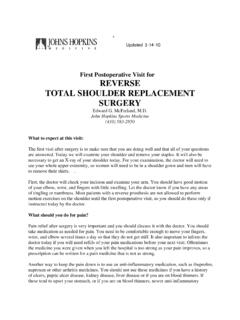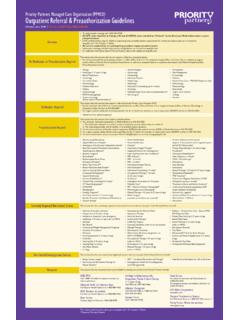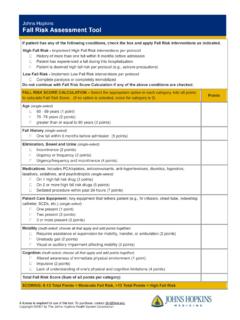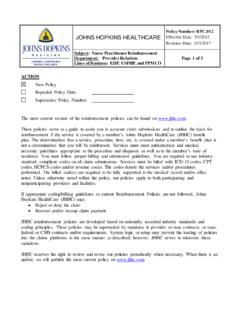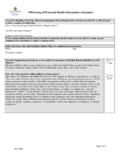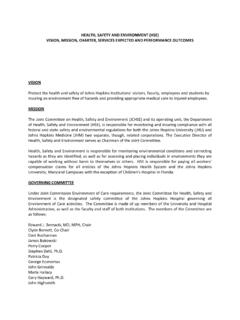Transcription of The Skinny on Visceral Fat - Hopkins Medicine
1 Diabetes Education #14 The Skinny on Visceral Fat Fat stored deep in the belly is the most harmful kind. Find out how to cut it down to size. People can carry their extra weight in different places on the body: All over On the hips and thighs Around the waist. Years ago, we did not know that where we carry extra weight matters. Now we know it does. Scientists have found that one place within the belly is most harmful. It is worse for your health than fat anywhere else in the body. In fact, a large waist size makes you more likely to get heart disease.
2 It is just as harmful for your heart as high blood pressure and smoking. Fat around the belly makes you more likely to have a heart attack. It also makes you more likely to have a stroke. These are the leading causes of death in diabetes. This type of fat makes it hard for your body to use its own insulin ( insulin resistance ). And, it may even lead to certain cancers. Read on to learn more about belly fat. There are steps you can take to avoid gaining weight around your middle. Understand your risk Our bodies have fat just under the skin.
3 But there is another layer of fat that is deeper (called Visceral fat). This is deep within a cavity in the belly. It surrounds some of the vital organs of the body. They are: the stomach, the liver, and the intestines. In fact, this fat is very close to the liver. It is so close that the liver can turn it into cholesterol. From there, this fat goes through the bloodstream. It may collect along the walls of the arteries. This leads the arteries to get hard and narrow (called atherosclerosis ). Diabetes Education #14 You may be more likely to get health problems from this kind of belly fat if: You waist is more than 40 inches if you are a woman Your waist is more than 35 inches if you are a man.
4 And it is not just people with diabetes who are at risk. Deep belly fat is a problem in healthy adults. It makes it harder for the body to use insulin well (causes insulin resistance ). This often leads to type 2 diabetes. Here is what we found in one study at Johns Hopkins . Take a man with a big waist size (over 40 inches). Compare him to a man with a small waist size (29 34 inches). The man with the big waist is 12 times more likely to have diabetes. Know the source of your deep belly fat Our genes certainly play a part in our body shape.
5 But we can still do a lot to stop a bulging waist and the health risks that come with it. Diet and exercise are two things we can control. And, these determine how much fat builds up in our bodies. Watch how much you eat of foods that are high in fat and calories. These foods can lead to obesity. For many, this extra weight goes to the stomach area. You should keep overall fatness and deep belly fat at bay. The American Diabetes Association (ADA) suggests you: Keep total fat to 20 to 30 percent of your total calories Keep saturated fat to less than 7 percent Limit harmful trans fats.
6 Here is an example. What if your diet has you eat a certain number of calories a day (such as 2,000)? Then, you would eat no more than: 700 calories (about 77 grams) of fat 140 calories (about 15 grams) of saturated fat There are many common sources of the bad (saturated) fats. They are: Foods from animals (dairy and meats) Some plants (coconut and palm oils) Packaged snacks and desserts. Diabetes Education #14 To lower your intake of these fats, stick with low-fat milk and yogurt; lean cuts of meat and poultry, without the skin; heart-healthy margarines; and good fats like olive, canola and safflower oils.
7 You can find out how much fat is in most packaged and fast foods. Be sure to check the nutrition facts panel. It lists how much total fat and saturated fat are in the food. Exercise to keep fat at bay But, diet is only part of the equation. Researchers have found that exercise plays a key role. It works to prevent and to reduce the build-up of belly fat. Here is what some studies have found. Diet alone is not enough to reduce deep belly fat. A study looked at the effect of diet and exercise. The study had 33 older women take part in it.
8 They were all obese and had type 2 diabetes. It looked at 3 ways to lose weight: a low-calorie diet; a low-calorie diet plus walking for 50 minutes 3 times a week, used as exercise; or just walking. This lasted for 14 weeks. The low-calorie diet did not work on belly fat. But, diet plus exercise (walking) did. And, just the exercise (walking) worked too. Those two groups lost about the same amount of belly fat. Exercise is key to prevent and lose belly fat. Here is what the first major study found (published in 2005 in the Journal of Applied Physiology).
9 There were 175 people who took part in this first study. These were people who did not do exercise. They were all overweight. They were put into 1 of 4 groups: a no-exercise group; or 1 of 3 exercise groups. After just 6 months, there were differences in belly fat. Those in the no-exercise group gained more belly fat. But not the people in the exercise groups. They were able to prevent or lose belly fat. Doing just a moderate type of exercise works best. The scientists in this last study found something else. Doing just a moderate type of exercise worked well.
10 This was a brisk 30-minute walk, 6 days a week. It was enough to prevent more build-up of belly fat. And, doing more not harder exercise worked best to lose belly fat. These results all suggest a clear message. Exercise is a key part of losing belly fat. Diabetes Education #14 Include both aerobic and resistance exercise Exercise is the key to fighting deep belly fat. But, what is the best exercise plan? According to the experts, your best bet is to combine two types. They are: Aerobic exercise Strength training (also called resistance training ) such as weight lifting.
